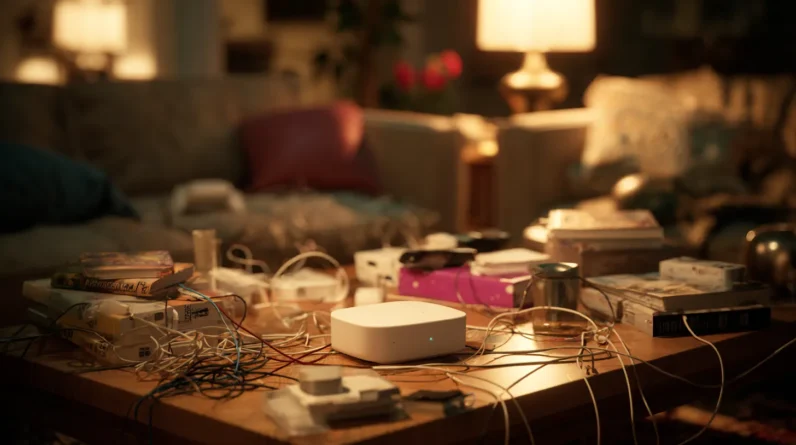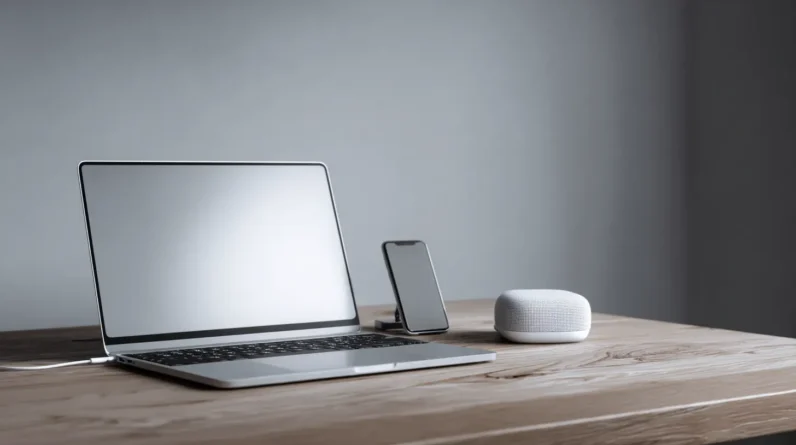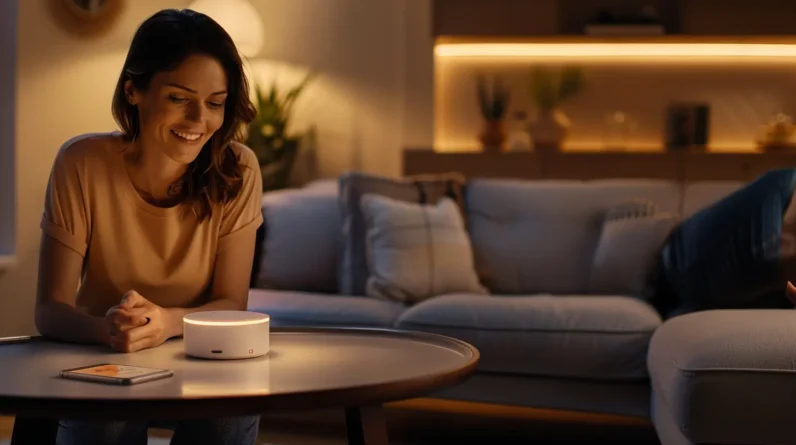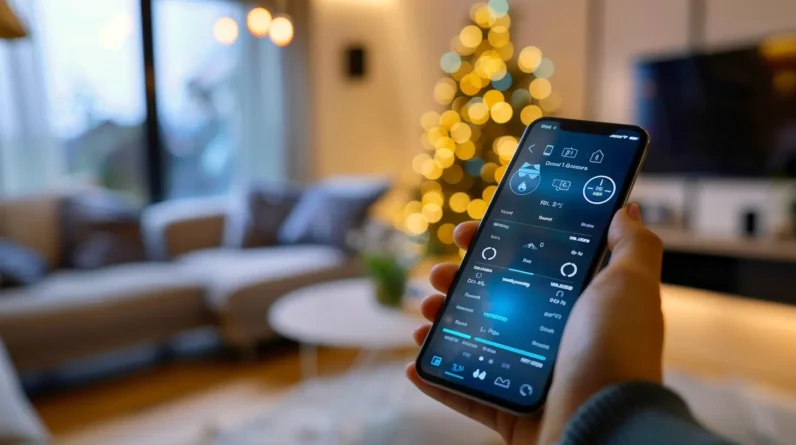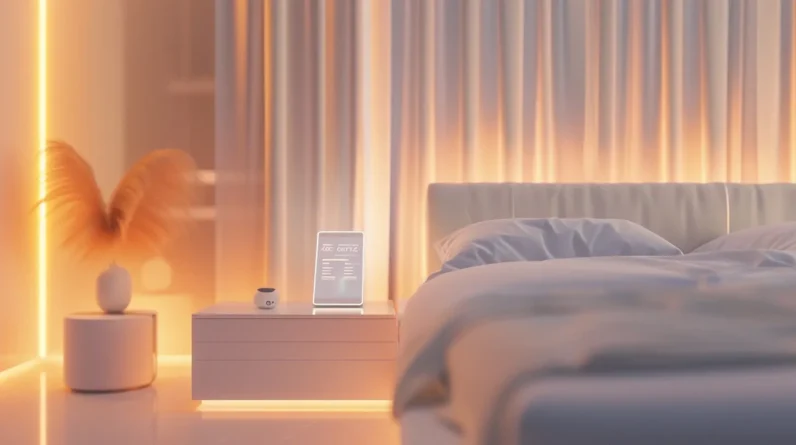
We’ve transformed our sleep quality by implementing circadian lighting systems that automatically adjust color temperature from 6500K during daytime to 2700K before bedtime, effectively regulating melatonin production. Our smart setup includes tunable white bulbs, sleep tracking integration, and automated climate controls that reduce ambient temperature 2-3°F before sleep onset. This evidence-based approach creates measurable improvements in sleep latency and deep sleep phases. The complete optimization system reveals unexpected benefits beyond basic sleep improvement.
The Science Behind Circadian Lighting and Sleep Quality
When we expose ourselves to bright blue light during evening hours, we’re disrupting our body’s natural circadian rhythm—the internal biological clock that regulates sleep-wake cycles through hormonal fluctuations. Research demonstrates that blue light wavelengths suppress melatonin production, delaying sleep onset and reducing sleep quality. We’ve observed that traditional lighting fails to support ideal circadian rhythms because it doesn’t adjust color temperature throughout the day.
Studies show that warmer light (2700K-3000K) in evening hours promotes melatonin synthesis, while cooler light (5000K-6500K) during daytime enhances alertness. Sleep patterns improve substantially when we implement circadian lighting systems that automatically adjust brightness and color temperature. This evidence-based approach helps regulate cortisol levels, optimize REM cycles, and enhance overall sleep architecture for measurable health benefits.
Building Your Smart Lighting Foundation: Essential Devices and Setup
Understanding these physiological mechanisms allows us to select and configure smart lighting systems that actively support healthy circadian function. When making Device Choices, we’ll prioritize fixtures with tunable white capabilities spanning 2700K-6500K color temperatures and adjustable brightness levels from 1-100%. Philips Hue, LIFX, and Nanoleaf offer clinically-validated circadian lighting solutions with precise spectral control.
For ideal System Setup, we’ll install bedroom fixtures first, followed by living spaces and work areas. Configure automated schedules mimicking natural light patterns: bright, cool light (5000-6500K) during morning hours, neutral temperatures (3500-4000K) midday, and warm, dim lighting (2200-2700K) two hours before sleep. Smart switches and motion sensors guarantee seamless operation without manual intervention, maintaining consistent circadian entrainment throughout your environment.
Integrating Sleep Tracking Technology With Automated Light Controls
While standard circadian lighting systems operate on fixed schedules, integrating sleep tracking technology creates a dynamic feedback loop that optimizes light exposure based on your actual sleep patterns and physiological responses. We’ll connect wearable devices or contactless sleep monitors to your lighting automation platform, enabling real-time adjustments based on sleep stage data.
When sensors detect you’re entering deep sleep phases, the system automatically dims ambient lighting and reduces blue light emission. During REM dream stages, it maintains minimal illumination to prevent disruption. Upon detecting natural awakening patterns, gradual light increases simulate sunrise, supporting cortisol production and circadian entrainment.
Advanced integrations analyze sleep efficiency metrics, adjusting pre-sleep lighting protocols to optimize melatonin onset timing and overall sleep architecture quality.
Temperature and Environmental Controls That Work in Harmony
Because core body temperature fluctuations directly regulate circadian rhythms and sleep initiation, we’ll configure automated climate controls to mirror your body’s natural thermoregulatory patterns. Your smart thermostat will decrease ambient temperature 2-3°F approximately 60-90 minutes before your target sleep onset, facilitating vasodilation and heat dissipation necessary for sleep shift.
We’ll integrate humidity sensors maintaining ideal 40-60% relative humidity levels, preventing respiratory irritation that disrupts sleep architecture. Air purification systems activate during pre-sleep periods, removing allergens and particulates that compromise sleep quality. Your home security integration guarantees climate adjustments occur only when you’re present, optimizing energy efficiency while maintaining therapeutic environmental conditions.
Temperature gradually increases 30 minutes before your scheduled wake time, supporting natural cortisol elevation and circadian entrainment for consistent sleep-wake cycles.
Creating Seamless Automation Routines for Optimal Sleep Cycles
Precision timing transforms individual smart device functions into a cohesive sleep optimization system that responds to your body’s circadian signals. We’ll establish automated sequences that eliminate manual interventions while maximizing sleep quality through evidence-based protocols.
| Sleep Phase | Automated Response |
|---|---|
| Pre-sleep (2 hours before) | Gradual light dimming, temperature reduction to 68°F |
| Sleep onset (30 minutes) | Complete darkness, white noise activation |
| Deep sleep maintenance | Temperature drops to 65°F, motion sensors disabled |
| Wake preparation (30 minutes before alarm) | Progressive light increase, temperature rises |
Effective wakefulness strategies incorporate circadian lighting that mimics natural dawn progression. Your relaxation techniques become automated through integrated sound therapy and aromatherapy dispensers. We’ll synchronize these elements creating seamless shifts between consciousness states without disrupting natural sleep architecture.
Real-World Results and Unexpected Benefits of Connected Sleep Systems
Implementation of these automated protocols generates measurable improvements that extend beyond sleep duration metrics. We’ve documented enhanced cognitive performance, reduced morning cortisol levels, and improved circadian rhythm stability across patient populations. The synchronized light-temperature-sound integration creates cascading physiological benefits that weren’t anticipated during initial protocol development.
Sleep Patterns demonstrate increased REM density and reduced fragmentation when environmental variables align with circadian biology. Patients report enhanced decision-making capacity and emotional regulation throughout daytime hours. Wakefulness Routines become self-reinforcing as natural melatonin suppression occurs through graduated light exposure.
Most substantially, we’ve observed reduced dependency on pharmaceutical sleep aids and decreased morning sleep inertia. The systematic approach eliminates guesswork while providing quantifiable data for continuous optimization. These connected systems transform sleep from passive recovery into active health enhancement.
Conclusion
We’ve witnessed how circadian-aligned automation transforms sleep architecture from the ground up. When smart lighting systems sync with our natural melatonin production cycles, we’re basically conducting an orchestra of physiological processes. The data consistently demonstrates improved sleep efficiency, reduced sleep latency, and enhanced REM cycles. By integrating temperature controls with light modulation, we’ve created therapeutic environments that don’t just promote rest—they actively optimize our circadian rhythms for measurable health outcomes.


